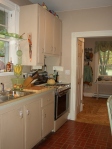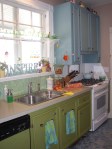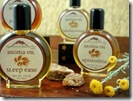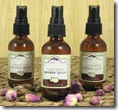Posts Tagged: interior design
What Is That Wonderful Scent?
My Mother would spray Lysol® in our home all the time while I was growing up. It’s purpose is to clean, disinfect and remove odors. I remember getting a headache if I walked into the “cloud” as she sprayed. I also remember the perfume my Mother wore, Chanel #5 and later Liz Claiborne. I know that if a stranger walked by wearing either fragrance today, I would stop and thoughts of my Mother would bring a smile to my face (and then I would probably sneeze!). When I think of Christmas time, I immediately have aromatic thoughts of the scent of cookies baking, applesauce on the stove top simmering with cinnamon and the smell of the freshly cut pine tree in our living room. Whether I smell the fragrance or think of a setting, scent is a very important aspect of my memories and feelings regarding my surroundings. When I am designing spaces for my clients, I like to think that I am helping to create beautiful visual spaces for them to live in along with touching upon their other senses for a full experience.
As I have shared in past blog postings, I have learned that I have chemical sensitivities to certain products out-gassing within my living and working environments. I have also realized that “perfumes” and certain fragranced products give me headaches as well. Once I discovered essential oils about 6 years ago as an alternative to perfumes, I was able to wear scents again and I also learned how to incorporate these essential oils into my environments through aromatherapy.
Aromatherapy may have origins in antiquity with the use of infused aromatic oils, made by macerating dried plant material in fatty oil, heating and then filtering. Aromatherapy is a form of alternative medicine that uses volatile plant materials, known as essential oils, and other aromatic compounds for the purpose of altering a person’s mood, cognitive function or health. Distilled essential oils have been employed as medicines since the invention of steam distillation in the eleventh century. The effectiveness of aromatherapy is yet to be scientifically proven, however some evidence exists that essential oils may have therapeutic potential.
The modes of application of aromatherapy include:
- Aerial diffusion: for environmental fragrancing or aerial disinfection
- Direct inhalation: for respiratory disinfection, decongestion, expectoration as well as psychological effects
- Topical applications: for general massage, baths, compresses, therapeutic skin care
An essential oil diffuser enables you to diffuse essential oils throughout your home or office. Diffusing is a simple and effective way to use essential oils. I use an air pump diffuser model for diffusing oils in my home and office. With a diffuser, oils are dispersed in a micro-fine vapor, allowing them to remain suspended in the air for extended periods of time. The diffuser disperses the oils without heating them so they retain their natural benefits. You can leave the diffuser on for a few minutes or for several hours. When inhaled, the oils are easily absorbed through the lungs. Depending on the oil used, diffusing can cleanse the air of odor, calm one’s mood and possibly help in one’s health regimen.
Essential oils that are inhaled into the lungs offer both psychological and physical benefits. Not only does the aroma of the natural essential oil stimulate the brain to trigger a reaction, but when inhaled into the lungs, naturally occurring chemicals may supply therapeutic benefits. Diffusing eucalyptus essential oil to help ease congestion is a great example.
Essential oils are natural and contain the true aromatic essence and other naturally beneficial properties of the plant the essential oil was distilled from. Essential oils are not the same as fragrance oils, perfume oils or potpourri oils. Essential oils contain only the distilled essence of a plant, perfume and fragrance oils are artificially created fragrances, containing artificial substances or are diluted with carrier oils and do not offer the benefits that essential oils offer. Look for products that contain pure essential oils on their ingredient list and avoid those that have words like fragrance. Some sellers of good-quality aromatherapy blends do not list their ingredients because they are worried that others may copy their creation. Good suppliers should be happy to provide you with a list of the ingredients. They understand that some individuals must avoid particular oils due to health problems.
General Household Freshening – Add a few drops of essential oil to your trash can, laundry wash, drain, vacuum bag filter, or on a tissue for placement in your drawers.
Bug Repellent – Many essential oils including citronella, lavender, and peppermint act as a natural repellent against insects.
When thinking about the interior air quality of our environments, I believe that using products that employ natural essences compared to artificially created fragrances are a must. If you are interested in learning more about aromatherapy, purchasing an oil diffuser, or other questions related to interior design, please contact me at [email protected] or call me at 978-335-1140.
Here are a few of my favorite companies for essential oils and their other offerings:
Julie and Julia and Lisa’s Kitchen
 This past weekend I saw the movie Julie & Julia with my two sisters. We all met in Boston to celebrate our combined birthdays. Dinner and a movie in the city. Perhaps a little late night dancing if we were up to it afterwards. We have traditionally gone out to the Burlington area, since that is a midpoint for all of us to meet, and eat dinner first and then rush to get to the movie. This time, not only would we change locations, but we would also change the order of our evening. We decided to see the movie prior to eating dinner so that we would have even more to talk about as we dined!
This past weekend I saw the movie Julie & Julia with my two sisters. We all met in Boston to celebrate our combined birthdays. Dinner and a movie in the city. Perhaps a little late night dancing if we were up to it afterwards. We have traditionally gone out to the Burlington area, since that is a midpoint for all of us to meet, and eat dinner first and then rush to get to the movie. This time, not only would we change locations, but we would also change the order of our evening. We decided to see the movie prior to eating dinner so that we would have even more to talk about as we dined!

Leslie, Elizabeth & Lisa
How, you might be wondering does this blog entry relate to the previous topics I have blogged about regarding interior design or even green interior design? I am not sure, but I am hoping that if I keep writing, something karmic will occur that will connect two of the creative outlets in my life. Interior design and food!

Julia Child's kitchen
As I watched this movie, I did experience an insight that I will share. Towards the end of the movie, (I won’t give the ending away!) they show Julia in her Cambridge kitchen. I elbow my sister Leslie and whisper to her to take a look at Julia’s kitchen cabinets. They are not natural cherry, walnut nor maple, they are a painted finish. In addition, they are painted two different colors. The upper cabinets are a soft blue and the base cabinets are a green. Her counter tops are butcher block, with the kitchen table in the center of the room. And who could forget the pegboard with the outlines of the pans drawn by her husband! It was the cabinets that made me elbow my sister. The reason being: my kitchen cabinets are painted exactly the same colors! Maybe not exactly the same, but I had used C2 Jamestown Blue for my upper cabinets and C2 Terrapin Green for my base cabinets.

before image of my kitchen
Do you think that twenty years after watching week after week of this program and admiring Julia’s kitchen and cooking skills I had subconsciously put those cabinet colors into my mind waiting for the opportunity to cover my doors with them? When we had moved into our home in Hamilton, the kitchen cabinet doors were painted Benjamin Moore’s White Dove. I immediately slapped paint onto them. However, it wasn’t the colors that I have shared with you. I had first painted them Benjamin Moore’s Iced Mauve, a soft grayish purple. That lasted a few months before I changed it. What was I thinking? Purple was great in the bathroom, bedroom or even a hallway, but it just wasn’t working in the kitchen. Then I painted on two tones of warm taupe. The lighter color going on the walls as well as the upper cabinets and a deeper tone in the same family of color going on the base cabinets. This was better, but not good enough. It was an uninspiring atmosphere to be attempting to create wonderful recipes.
This was going to require some more thought and effort. I had to treat my home the same way I do for my clients. I needed to look at the whole picture and not just a quick fix to add some color to a plain cabinet front. My inspiration, at least this is what I had believed was where the color scheme had come from at the time: was my love for living near the ocean. Actually, any body of water. There was the color of the shore with the plants of the dunes, the wooden boardwalk, the sand, that point where the waves crash along the shore and create white frothy foam, the color of the ocean, the color of the seaweed in the ocean and the color of the changing sky. Blue, beige, white, and green would be the main colors, with small accents of orange, yellow and red (as seen in a setting sun) coming into play with fresh flowers and accessories. That was my palette. And, as I realized this weekend, it was for Julia as well.

after image of my kitchen
I kept the warm light taupe that I had already painted on the walls (that could represent the sand). It was a comforting background without being as boring as white walls. My husband then added some creative molding to the cabinet doors to give them a bit more definition and detail. We also added new brushed nickel hardware for the knobs, pulls and hinges. Then, some sanding, priming and the final paint color on the cabinet doors and frames. I was now almost able to enjoy being in this space to cook and entertain for family and friends.
I must confess, the worst problem in this kitchen wasn’t the cabinet or wall colors, it was the flooring. We had inherited a kitchen with that aged vinyl flooring in the large brick pattern. There were some bare areas where old cabinetry had been removed and we had exposed sub floors, along with the peeling up of edges near the doorways. I hated this floor. I pretended it didn’t exist. It didn’t look clean even after scrubbing it. It was so old and gross that I didn’t allow my gaze to go below the height of the chair seat. I tried not to notice that horrid brick color.

new kitchen flooring
As an interior designer, I have access to many showrooms and dealers for flooring. Since the first day we moved into our home, I had been searching for a kitchen floor that not only would be visually interesting but would also be within the budget we were working with. I loved Marmoleum and looked into using that. We just couldn’t afford it at the time. The rest of the house had beautiful original 100 year old hardwood floors. I didn’t want to duplicate that, I wanted something different. The inspiration came when we were having dinner at our good friends’ home and I went to check out their kids’ new bathroom flooring. They had purchased it at Lowe’s. It was stunning! It was a ceramic tile that measured 3” x 3” and was a funky blue pattern that reminded me of oil spots on pavement when the mist creates unique colors and patterns. I had found the ocean for my kitchen! The unusual small scale of the tile was an added bonus since we had some level changes that would not have worked if we had used a larger floor tile.
This same friend had also used a wall paper product called anaglypta on her wainscot in her dining room. It is a highly embossed paintable paper product that reminds me of old fashioned tin ceilings. This became my backsplash for most of my kitchen area. I chose to use small glass mosaic tiles for the area under my kitchen window and above the sink. It offered a waterproof solution to an area that would require just a swipe of cloth to clean it. I painted the anaglypta a high gloss bright white and used a light iridescent green color for the glass tiles. I even found a dinner plate pattern by Corelle that worked beautifully with the redesign of the kitchen.
It offered a waterproof solution to an area that would require just a swipe of cloth to clean it. I painted the anaglypta a high gloss bright white and used a light iridescent green color for the glass tiles. I even found a dinner plate pattern by Corelle that worked beautifully with the redesign of the kitchen.
Bon appétit!
www.pbs.org/juliachild/, www.c2paint.com, www.corelle.com
For any thoughts or questions, please feel free to contact me, Lisa Kawski at [email protected]





